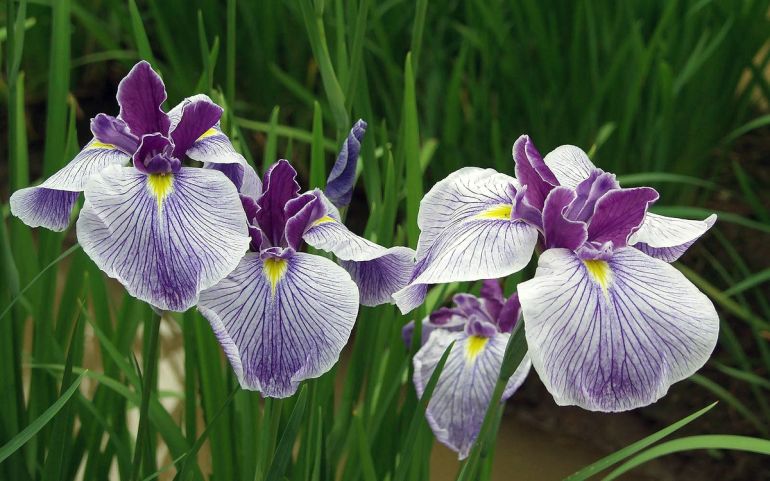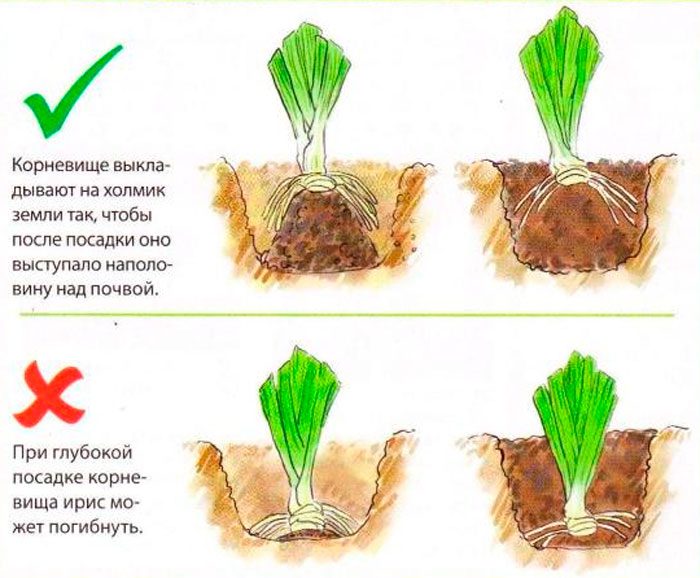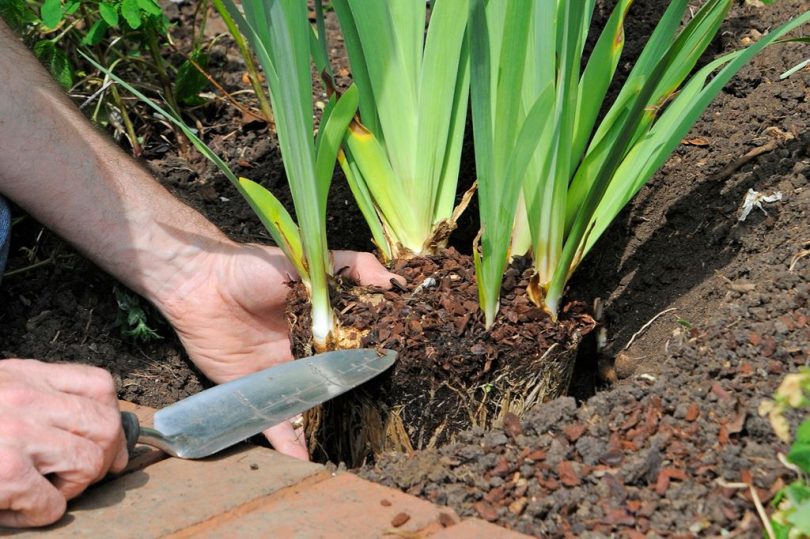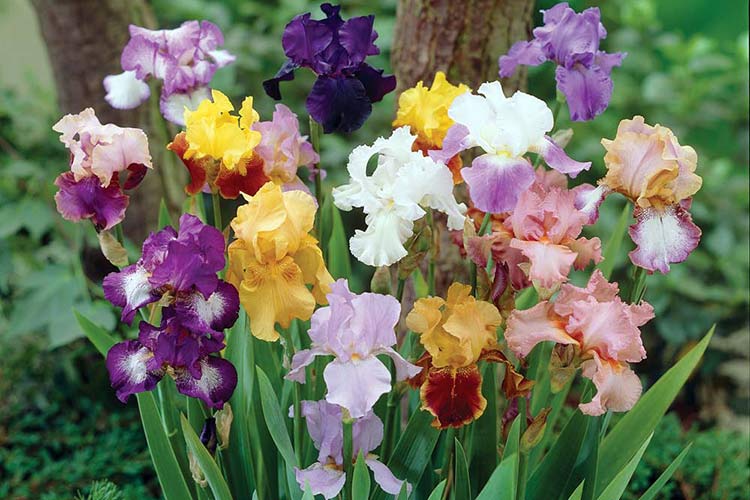Content:
Irises are very popular flowers among many gardeners. The culture is unpretentious in requirements and feels great in the open field. If it was decided to plant them on the land plot, the process should be approached thoroughly.
About planting irises
The primary task is to determine the place where planting and soil preparation will be carried out. Irises love sunny, open, but calm areas. If the flowers cannot be protected from the wind, they are tied to a support so that they do not break with an air gust. Light shading is not scary for them, but if the place is heavily shaded, this has a detrimental effect on the growth of irises and their ability to bloom.
You can plant these flowers in any soil, but their favorite is loamy or sandy loam soil with a low acidity. If the soil in the territory is sour, then irises can also be planted, but in this case they will grow strongly and will not please with flowering. In addition, on such soil, they most often begin to develop various diseases, in particular, a very dangerous bacteriosis. Therefore, if possible, it is recommended that liming is carried out in excessively acidic soils or the pH values are lowered with wood ash or chalk.
Another important fact before planting irises is that they have an extremely negative attitude to the close location of groundwater to the surface and, in general, to excess moisture in the ground (with the exception of the aira-like or bog iris).
Despite the fact that excess moisture has a bad effect on flowers, at a certain time they still have an increased demand for watering (this is the period of budding, flowering, with active growth of the vegetative mass).
After determining the site for planting, preliminary preparation of the land is needed. All weeds and roots must be removed. A good top dressing will be the introduction of rotted manure and compost into the soil. It is important that manure is just rotted, since fresh manure leads to rotting of iris rhizomes.
If irises are planned to be planted for the first time, then when buying planting material, you should be careful and pay attention to:
- on the size of the rhizome, whether it is overdried;
- on the state of health and the absence of any diseases or pests;
- how vegetative buds are formed.
The best option for buying a flower is if it is not easy to sell one rhizome and greens, but there is also a peduncle.
Why plant iris
When the flower is 4-5 years old, the bush will necessarily expand in breadth by this time and require division. It is advisable to renew and divide all irises every 3-5 years in order to maintain their ability to bloom and prevent degeneration. To do this, you need to know in advance when it is best to plant irises in terms of time and what nuances should be taken into account.
When to plant irises
Florists transplant irises in spring and summer (after the petals have fallen off the flower), and in autumn (if it is warm). Despite the fact that the principle of transplantation remains the same, nevertheless, each selected period has its own characteristics that must be taken into account.
How to plant irises in spring
In the spring, planting material bought in a store or overwintered in a shelter needs to be treated with a growth stimulant. After winter, seedlings may be too weak, and this will only increase the chances of successful rooting.
Roots that are too long need careful pruning. The rotted parts of the rhizomes are also removed.
Step-by-step disembarkation process:
- A small hole is dug into which a little sand is poured into a mound.
- A rhizome is placed horizontally in the hole, which must be straightened.
- Almost the entire hole is covered with earth, but the upper part of the rhizome must be left on the surface to prevent the flower from rotting. A new hole is made at a distance of 40-50 cm from the previous one.
- The planted plant is watered.
How to plant irises in summer
In summer, it is better to plant irises two weeks after the plant has faded. For many varieties, the appropriate period is July and August. If you choose this particular time, then the first flower stalks will appear already in the first year after transplantation and there will be no fear that the culture will not have time to take root before the onset of cold weather.
It is necessary to dig the plant out of the ground together with the roots and leaves very carefully, and it is better not with a shovel, but with a pitchfork, so as not to harm the flower. After that, the bush is carefully examined and the rhizome is divided into separate divisions. There are 2 ways to split the roots of irises: with your hands and with a knife. The first one is most often used, since when breaking the damage is less than when cutting with a knife.
An additional preventive measure will save from the development of bacteriosis and other diseases - keeping the cuttings for 1-2 hours in a solution of potassium permanganate (10 g of the substance are taken for 10 liters of water), followed by four hours of drying. Many gardeners, moreover, are in no hurry to plant young bushes in place immediately after separation, but wait about a week to allow the cuttings to drag on and see if any diseases begin to develop.
The roots and leaves are shortened immediately before planting. The roots are cut to a length of 10 cm, and the leaves are cut "on a cone", leaving 10-15 cm.
If the iris variety is tall, planting holes should be 40-50 cm apart, if it is dwarf, then 20 cm will be enough. The depth of each hole is up to 10 cm. After the holes are filled in, each hole is slightly compacted with your hands from above.
How to plant irises in autumn
Sometimes the summer is extremely hot and dry, and the right decision would be to postpone the moment of seating until autumn. At this time of the year, the growth phase of the flower is activated, which helps it to take over and get accustomed to new conditions. If you deal with this issue back in September, then there will be no difficulties. This month is not yet very cold, and the irises will have enough warmth and strength for rooting, but if you drag it out until late autumn (for example, after mid-October), then transplanting is unlikely to benefit the culture. During this period, it gets colder rapidly, so the likelihood of the flower wilting and the inability to get used to a new place are too great.
However, the autumn transplant has positive aspects:
- Rhizomes are not forced out to the surface of the earth, and therefore, the abundance and duration of flowering does not change.
- Since the phase of active growth begins, the greatest growth of the bush is noted, which is good for further breeding.
Useful tips for transplanting irises
Of all varieties of irises, undersized ones bloom first (their height is 25-35 cm). They look very nice on the front of flower beds and along the edge of garden paths. In June, medium-sized irises (37-70 cm in height) are already pleasing in color, and the highest (more than 70 cm) bloom from June to July.Such convenient flowering times allow the culture to be used to decorate the entire site, and thanks to the unpretentiousness of irises, they can be planted in any corner of it. This culture is especially beautifully combined with undersized flowers of other species, but it is better that they are about the same tone. In addition, irises look great next to coniferous bushes.
Despite the fact that iris loves moisture, it is impossible to store its roots in polyethylene until planting, so only their rotting is provoked and they will disappear. Better to store them in newspaper or onion skins.
It often happens that the bush grows well, but does not bloom in any way. To understand the reason, you should check:
- Has the plant been planted too deep. Deep planting prevents the sun from warming the rhizome, and such irises will only grow leaves without stalking.
- Is there enough light. Lack of light is one of the most common reasons why irises lose their blooming power.
- Was the wintering done correctly? With too early shelter, the roots mate, and with late shelter, they freeze slightly. Both are detrimental to culture. However, some varieties, for example, Siberian, are not afraid of the cold, and you don't have to worry about preparing a shelter.
- Whether the irises have enough room for normal growth. If you keep the culture in one place for too long, the flowers begin to lean closer to each other, pressing so hard that the peduncles have nowhere to appear.
Many experienced gardeners recommend orienting the iris rhizome when planting to the south, as this will allow it to warm up better by the sun, which means more new buds will form. The fans of all iris plantations should be optimally placed along the row, this will allow you to keep the flower bed neat, and even if the plants move as they grow, the appearance of the flower garden will not be affected.
Irises are so attractive and easy to grow that you can see them in parks, gardens, and near entrances. Each variety is beautiful in its own way, and it will not be difficult to find something to your liking.

















